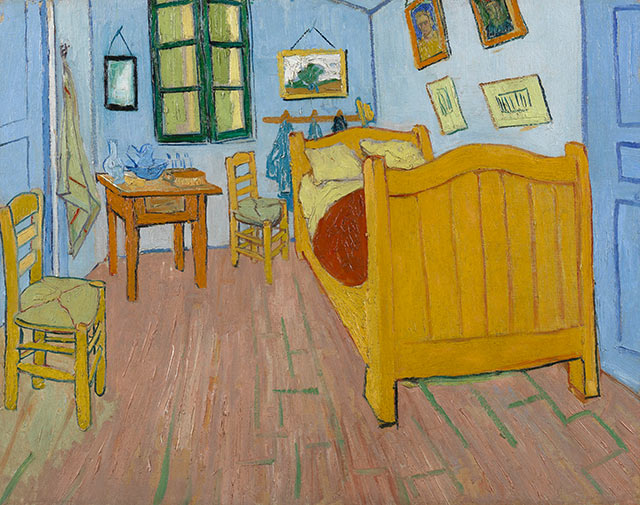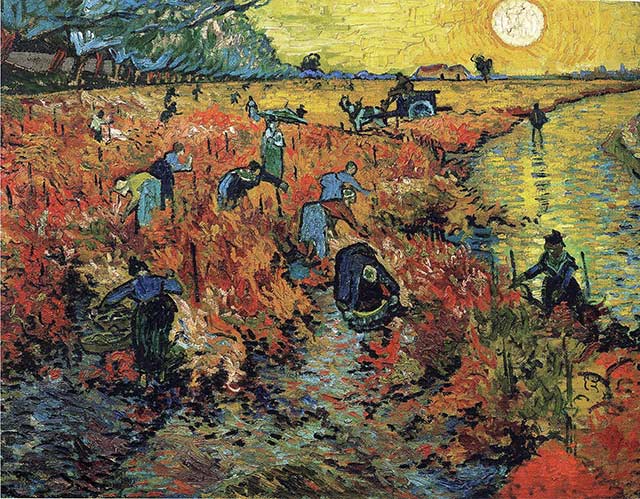Here, we honour Vincent van Gogh by taking you on a visual walk through some of his most famous works, accompanied by quotes from the numerous letters written by the brilliant yet troubled Dutch post-Impressionist painter to his brother, Theo van Gogh:
The Potato Eaters, 1885. The Van Gogh Museum, Amsterdam.

Painted in Nuenen, Netherlands, Potato Eaters depicts the harsh reality of peasants, with dark, gloomy palette of greens and browns and rough, scrawny subjects.
“I really wanted to make it so that people get the idea that these folk, (…) have tilled the earth themselves with these hands they are putting in the dish, and so it speaks of manual labour and – that they have thus honestly earned their food.”
The Bedroom, 1888. The Van Gogh Museum, Amsterdam.

This is Van Gogh’s painting of his bedroom in the Yellow House, Arles, France. Simple furniture and his own paintings adorned the room. Van Gogh had hoped his paintings would bring comfort, thus the simple interior and bright colours.
“When I saw my canvases again after my illness, what seemed to me the best was the bedroom.”
Sunflowers, 1889. The Van Gogh Museum, Amsterdam.

Part of a series of decorative still life of sunflowers painted for Paul Gauguin, in hopes of welcoming (and impressing) his fellow artist and friend – and he did. Gauguin thought the final painting was “a perfect example of a style that is completely Vincent”.
Self-Portrait as a Painter, 1887-1888. Van Gogh Museum, Amsterdam.

Self-Portrait as a Painter was the last work Van Gogh produced in Paris. The French city had exhausted him both mentally and physically, as he portrayed himself “quite unkept and sad” in the painting. Soon after this, the artist set off in search of new surroundings in the South of France.
Red Vineyard near Arles, 1888. Pushkin Museum of Fine Arts, Moscow.

Van Gogh works were, sadly, ignored until after his death in 1890. Although he completed around 900 paintings in just over a decade, only one oil painting was sold while he was alive – The Red Vineyard. It was sold to Anna Boch, an impressionist painter and art collector from Belgium, at the annual exhibition of Les XX in 1890.
Starry Night Over the Rhone, 1888. The Musée d’Orsay, Paris.

Van Gogh painted this at the bank of the Rhone River, which was a one or two-minute walk from the Yellow House.
“The sky is aquamarine, the water is royal blue, the ground is mauve. The town is blue and purple. The gas is yellow and the reflections are russet gold descending down to green-bronze. On the aquamarine field of the sky the Great Bear is a sparkling green and pink, whose discreet paleness contrasts with the brutal gold of the gas. Two colorful figurines of lovers in the foreground.“
The Starry Night, 1889. The Museum of Modern Art, New York.

One of his most iconic paintings, Starry Night depicts the view from the east-facing window of Van Gogh’s asylum room at Saint-Rémy-de-Provence (he was admitted in 1889 after a breakdown that resulted in the self-mutilation of his left ear).
“I (…) need a starry night with cypresses or-perhaps above a field of ripe wheat; there are some really beautiful nights here.”
Blossoming Almond Tree, 1890. The Van Gogh Museum, Amsterdam.

This painting of delicate almond blossoms against a clear blue sky was done by Van Gogh for his new-born nephew Vincent Willem. It was the work that remained closest to the hearts of the Van Gogh family.
Fun fact: Vincent Willem went on to found the Van Gogh Museum.
| SHARE THE STORY | |
| Explore More |




